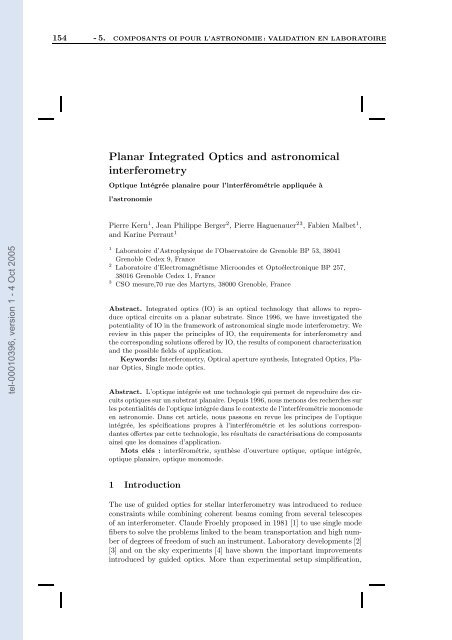Qualification de IONIC, instrument de recombinaison ...
Qualification de IONIC, instrument de recombinaison ...
Qualification de IONIC, instrument de recombinaison ...
You also want an ePaper? Increase the reach of your titles
YUMPU automatically turns print PDFs into web optimized ePapers that Google loves.
tel-00010396, version 1 - 4 Oct 2005<br />
154 - 5. COMPOSANTS OI POUR L’ASTRONOMIE : VALIDATION EN LABORATOIRE<br />
Planar Integrated Optics and astronomical<br />
interferometry<br />
Optique Intégrée planaire pour l’interférométrie appliquée à<br />
l’astronomie<br />
Pierre Kern 1 , Jean Philippe Berger 2 , Pierre Haguenauer 23 , Fabien Malbet 1 ,<br />
and Karine Perraut 1<br />
1<br />
Laboratoire d’Astrophysique <strong>de</strong> l’Observatoire <strong>de</strong> Grenoble BP 53, 38041<br />
Grenoble Ce<strong>de</strong>x 9, France<br />
2<br />
Laboratoire d’Electromagnétisme Microon<strong>de</strong>s et Optoélectronique BP 257,<br />
38016 Grenoble Ce<strong>de</strong>x 1, France<br />
3<br />
CSO mesure,70 rue <strong>de</strong>s Martyrs, 38000 Grenoble, France<br />
Abstract. Integrated optics (IO) is an optical technology that allows to reproduce<br />
optical circuits on a planar substrate. Since 1996, we have investigated the<br />
potentiality of IO in the framework of astronomical single mo<strong>de</strong> interferometry. We<br />
review in this paper the principles of IO, the requirements for interferometry and<br />
the corresponding solutions offered by IO, the results of component characterization<br />
and the possible fields of application.<br />
Keywords: Interferometry, Optical aperture synthesis, Integrated Optics, Planar<br />
Optics, Single mo<strong>de</strong> optics.<br />
Abstract. L’optique intégrée est une technologie qui permet <strong>de</strong> reproduire <strong>de</strong>s circuits<br />
optiques sur un substrat planaire. Depuis 1996, nous menons <strong>de</strong>s recherches sur<br />
les potentialités <strong>de</strong> l’optique intégrée dans le contexte <strong>de</strong> l’interférométrie monomo<strong>de</strong><br />
en astronomie. Dans cet article, nous passons en revue les principes <strong>de</strong> l’optique<br />
intégrée, les spécifications propres à l’interférométrie et les solutions correspondantes<br />
offertes par cette technologie, les résultats <strong>de</strong> caractérisations <strong>de</strong> composants<br />
ainsi que les domaines d’application.<br />
Mots clés : interférométrie, synthèse d’ouverture optique, optique intégrée,<br />
optique planaire, optique monomo<strong>de</strong>.<br />
1 Introduction<br />
The use of gui<strong>de</strong>d optics for stellar interferometry was introduced to reduce<br />
constraints while combining coherent beams coming from several telescopes<br />
of an interferometer. Clau<strong>de</strong> Froehly proposed in 1981 [1] to use single mo<strong>de</strong><br />
fibers to solve the problems linked to the beam transportation and high number<br />
of <strong>de</strong>grees of freedom of such an <strong>instrument</strong>. Laboratory <strong>de</strong>velopments [2]<br />
[3] and on the sky experiments [4] have shown the important improvements<br />
introduced by gui<strong>de</strong>d optics. More than experimental setup simplification,

















